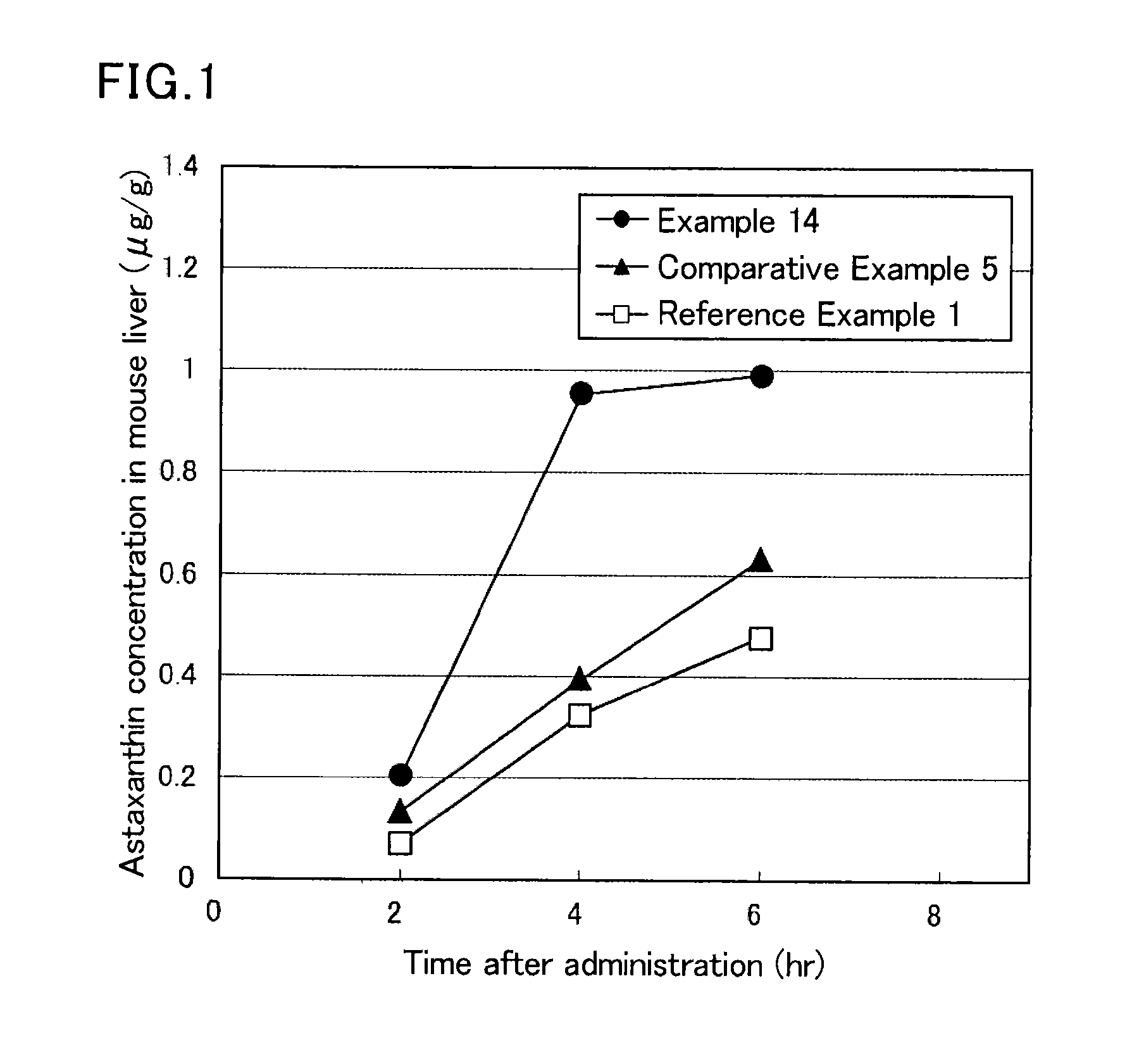Method for producing carotenoid composition
a carotenoid and composition technology, applied in the field of carotenoid composition production, can solve the problems of many biological contaminants in the carotenoid composition obtained by this method, the risk of process-related contaminants, and the danger of human health, and achieve the effects of simple production, efficient extraction and concentration of the carotenoid, and convenient industrial production
- Summary
- Abstract
- Description
- Claims
- Application Information
AI Technical Summary
Benefits of technology
Problems solved by technology
Method used
Image
Examples
synthesis example 1
[0134]An amount of 5 mL of a YM medium (containing 0.5% of polypeptone, 0.3% of yeast extract, 0.3% of malt extract, and 1.0% of glucose) was placed in each of four test tubes and inoculated with the KNK-11 strain, which was a mutant strain prepared by mutagenesis of Xanthophyllomyces dendrorhous NBRC 10129 (available from Biological Resource Center, National Institute of Technology and Evaluation (2-5-8 Kazusa-Kamatari, Kisarazu-shi, Chiba, 292-0818, Japan)) with NTG. The strain was incubated at 20° C. for 48 hours. The culture fluids were transferred to four 500-mL sakaguchi flasks each containing 50 mL of a YM medium, followed by incubation at 20° C. for 48 hours. The culture fluids were transferred to a 5000-mL jar fermenter containing 2500 mL of a medium (containing 1.3% of ammonium phosphate, 0.7% of potassium phosphate, 0.3% of yeast extract, and 1% of glucose) and the strain was incubated at 20° C., thus obtaining a cell-containing culture fluid containing astaxanthin and HD...
example 1
[0136]To 32.3 g of the wet cells (containing 0.13 g of astaxanthin) obtained in Synthesis Example 1 was added 100 mL (79 g) of ethanol cooled to 5° C., and the mixture was stirred at the same temperature for 30 minutes. The resulting mixture was vacuum filtered to obtain a cake-1 and a filtrate-1. The astaxanthin concentration of the filtrate-1 was determined by high-performance liquid chromatography and found to be 0.005% by weight. To the cake-1 was added 800 mL (632 g) of ethanol and the mixture was stirred at 40° C. for 1 hour. The resulting mixture was vacuum filtered to obtain a cake-2 and a filtrate-2. To the cake-2 was further added 800 mL (632 g) of ethanol, and the mixture was stirred at 40° C. for 1 hour. The resulting mixture was vacuum filtered to obtain a cake-3 and a filtrate-3. The filtrate-2 and filtrate-3 were combined and the resulting liquid contained 0.11 g of astaxanthin. This liquid was vacuum concentrated until the amount thereof was reduced to 1 / 100, 1.63 g ...
example 2
[0137]To 646 kg of the wet cells (containing 2.58 kg of astaxanthin) prepared as in Synthesis Example 1 was added 2000 L (1580 kg) of ethanol cooled to 8° C., and the mixture was stirred at the same temperature for 30 minutes. The resulting mixture was pressure filtered to obtain a cake-1 and a filtrate-1. The astaxanthin concentration of the filtrate-1 was determined by high-performance liquid chromatography and found to be 0.005% by weight. To the cake-1 was added 16000 L (12640 kg) of ethanol, and the mixture was stirred at room temperature for 1 hour. The resulting mixture was pressure filtered to obtain a cake-2 and a filtrate-2. To the cake-2 was further added 16000 L (12640 kg) of ethanol, and the mixture was stirred at 40° C. for 1 hour. The resulting mixture was pressure filtered to obtain a cake-3 and a filtrate-3. The filtrate-2 and filtrate-3 were combined and the resulting liquid contained 2.13 kg of astaxanthin. This liquid was vacuum concentrated until the amount ther...
PUM
| Property | Measurement | Unit |
|---|---|---|
| viscosity | aaaaa | aaaaa |
| temperature | aaaaa | aaaaa |
| temperature | aaaaa | aaaaa |
Abstract
Description
Claims
Application Information
 Login to View More
Login to View More - R&D
- Intellectual Property
- Life Sciences
- Materials
- Tech Scout
- Unparalleled Data Quality
- Higher Quality Content
- 60% Fewer Hallucinations
Browse by: Latest US Patents, China's latest patents, Technical Efficacy Thesaurus, Application Domain, Technology Topic, Popular Technical Reports.
© 2025 PatSnap. All rights reserved.Legal|Privacy policy|Modern Slavery Act Transparency Statement|Sitemap|About US| Contact US: help@patsnap.com

